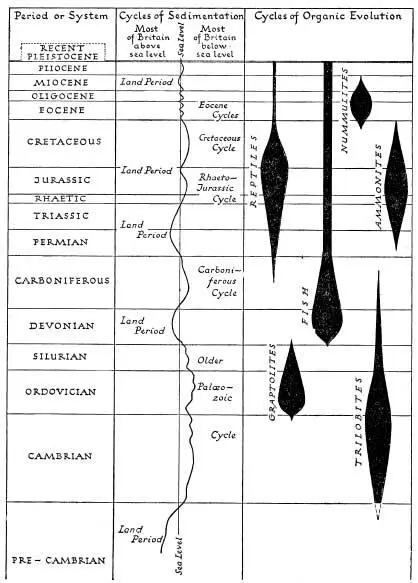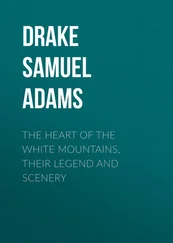morphe form, hence the process is called contact metamorphism).
FIG. 7.—Diagrammatic Section of an Unconformity A—B is the plane of the unconformity. After the deposition of the group of beds marked C they were gently folded by earth-building movements and were subjected to denudation. Gentle subsidence followed so that the group of beds marked D were deposited gradually over a larger and larger area—they rest unconformably on the older series and at the same time overstep them. In the centre of the basin fine-grained shales were deposited and the diagram suggests that sedimentation was almost continuous. Towards the margins of the basin the fine-grained deposits pass laterally into sands and other coarser sediments and to shore deposits.
This section represents diagrammatically the relationship between the Silurian and the underlying Ordovician in the Welsh Borderlands. See also Plate IV B.
Thus clay and shale are baked into hard slatey rocks, limestone is changed into marble. Some of the molten rock is very fluid when it is first poured out and spreads evenly over a wide surface as did the basalts of Northern Ireland; sometimes it formed hexagonal columns on cooling as at Giant’s Causeway and the Island of Staffa (Plate XVA). In other cases the molten rock was very sticky and consolidated almost on the spot—the famous conical “spire” of Mont Pele of Martinique in the West Indies is the best modern example of this (it was formed during the disastrous eruption in 1902) but there are many examples from earlier periods in the British Isles, such as Ailsa Craig in the Firth of Clyde. Even more important, though it cannot be observed at the surface, is the underground movement of great masses of molten “magma.” At the height of great earth-building movements the magma is squeezed into the core of mountain ranges so that millions of years afterwards, when the mountains have been denuded down to their roots, this core is exposed. A typical rock so formed is granite. The metamorphism caused by a huge granite mass taking eons to cool can perhaps be imagined rather than described and the “metamorphic aureole” is often very extensive; it is economically important because of the valuable metallic minerals which are associated with the gases and heated liquids given off by the magma. These latter often find their way into cracks or veins and there the minerals are deposited—hence the association of ores of tin and copper with the metamorphic aureoles of the granites of Devon and Cornwall. These Devon and Cornish granite masses are the roots or cores of giant mountains formed by the Armorican earth movements but long since worn down almost to a level surface. It is clear that there is a definite cycle of igneous activity associated with a cycle of earth movements—volcanic activity heralding the oncoming storm; intrusion and movement of huge underground masses at the height of the storm; and finally renewed volcanic activity when the storm is dying away. The few volcanoes on the surface to-day which are active may be regarded as the last remnants of the once wide-spread activity at the end of the Alpine earth movements. Many of those are at the end of their lives—dormant or even extinct or merely giving off vapours (“sol-fataric stage”). Hot springs and geysers are indications of a nearly dead volcanic area.
One of the still unsolved puzzles of earth history is whether or not there have been true climatic cycles in the past. There is no doubt that at several periods there have been ice ages, though perhaps nothing as severe as that which overwhelmed the northern hemisphere so recently in geological time that man was already well established and hence known simply as “the Ice Age.” We know definitely that some of the red rocks found in the British Isles—such as the Permian or New Red Sandstone—were laid down under desert conditions and there must have been other times when what is now our country must have been wet and hot. Many of the phenomena, however, may be explained by a different distribution of land and water in the past or at most by a shifting of the earth’s axis.

FIG. 8.—Major episodes in Earth History

FIG. 9.—Some characteristic Fossils.
Those numbered I are Palaeozoic; those numbered II are Mesozoic and III Cenozoic.
Graptolites:—Ia Monograptus (Silurian); Ib Diplograplus (Ordovician); Ic Didymo-graptus extensus (Ordovician); Id D. murchisoni (Ordovician). Trilobites:—Ie Phacops caudatus (Silurian); If Calymene blumenbachi (Silurian); Ig Ogygia buchi (Ordovician). Primitive fish:—Ih Pterichthys milleri and Ii Cephalaspis lyelli (Old Red Sandstone). Brachiopods:—Ik Spirifer verneuilli (Devonian); IIb Spiriferina walcotti,; 11c Rhynchonella rimosa and 11d Waldheimia numismalis (all Lias). Ammonites :—11a Dactylioceras commune (Lias); 11e Pcrisphinctes biplex (Jurassic, Kimerid-gian); 11f Hoplites splendens (Cretaceous: Gault); 11g Hamites attenuatus (Crctaceous: Gault): 11h Hoplites auritus (Cretaceous: Greensand). Nummulites: 111a Nummulites laevigatus (Eocene).
The existence of a plastic or semi-molten layer under the solid part of the earth’s crust has already been argued and there is nothing inherently impossible in the idea that the continents consist of relatively light rocks and form masses as it were floating on a plastic layer. If this is so, it is but one step towards the idea that the continental masses may drift away from or towards one another—hence the Theory of Continental Drift associated with the name of the German geologist Wegener. But the attempt to secure observational confirmation of drift, however slight, has been disappointing.
The similarity in the rocks which make up such widely separated lands as Africa, Peninsular India and western Australia is so striking, however, that this absence of direct observational proof of drift is inconclusive. It may be that drift only takes place at certain periods when the underlying rocks are in a particular condition of plasticity.
Amidst all the changing scenes which geological time has witnessed—for we may say that geology is really geographical evolution—there has gone on the evolution of living organisms. Just as in times of war things happen and life is speeded up so there is some evidence to show that the rapidly changing environmental conditions which must have characterised the great periods of earth movement induced a rapidity of organic evolution. Whether that be so or not the fact remains that before the Caledonian movements the world was populated almost exclusively by lowly plants which have left few traces and by invertebrate animals. After the movements was the age of fishes—the many weird forms of the Old Red Sandstone—and a rapid evolution of fern-like plants. Before the Armorican movements there were some amphibians but it is after the movements that we have the great age of reptiles and the seas became populated by the well-known coiled ammonites and innumerable brachiopods. The curious graptolites which scarcely survived the Caledonian movements had completely gone. The doom of the heavily armoured and small-brained Jurassic and early Cretaceous reptiles was sealed well before the earliest inklings of the Alpine movements. The victory of the mammals, with man himself to follow later, was assured long before the time the Alpine storm really broke.
Читать дальше














